Key takeaways:
- Gender equality advocacy is fueled by personal stories and shared experiences, emphasizing the importance of amplifying unheard voices.
- Campaigning for change shapes societal attitudes and creates platforms for marginalized voices, fostering solidarity among diverse groups.
- Key challenges include institutional resistance to change, lack of community awareness, and limited funding for grassroots efforts, highlighting the need for education and innovative solutions.
- Effective strategies involve building alliances, leveraging storytelling, and developing persistence in seeking support and funding.
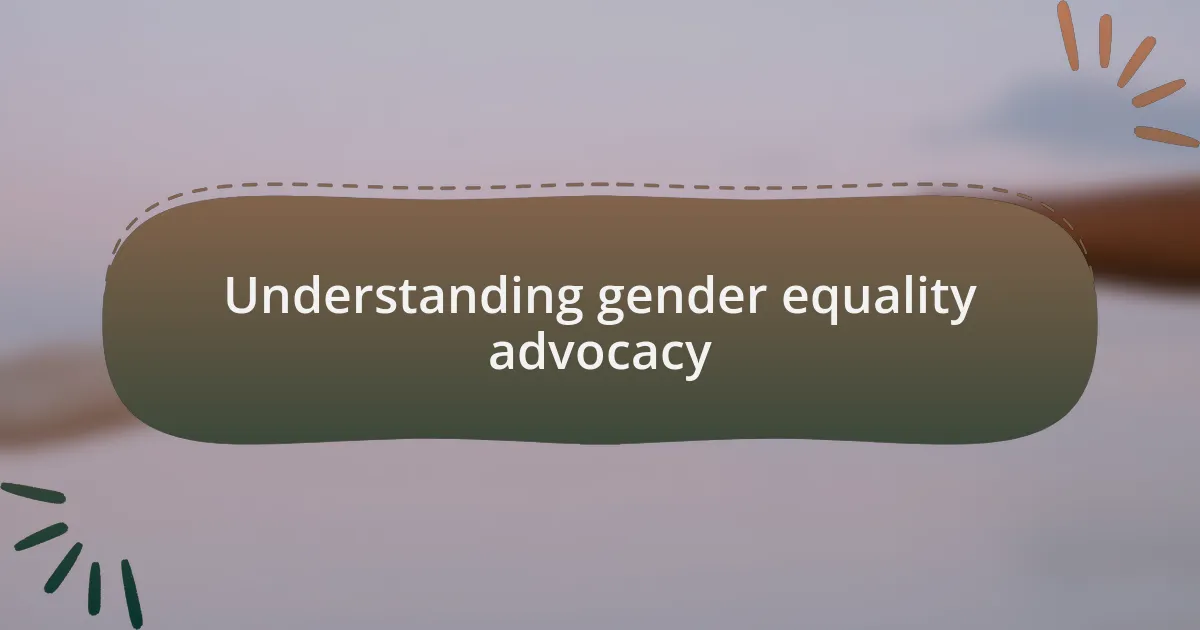
Understanding gender equality advocacy
Gender equality advocacy goes beyond merely raising awareness; it involves a passionate commitment to promoting equal rights and opportunities for all genders. I remember attending my first advocacy meeting and feeling an electric mix of hope and urgency in the room. It made me realize that this movement thrives on personal stories and shared experiences, pushing us to confront societal norms and question our roles in perpetuating them.
One of the most profound moments for me came when I heard a survivor of gender-based violence share her story. The tears in her eyes and her unwavering strength moved me deeply, reinforcing the idea that advocacy is about amplifying voices that often go unheard. It really made me think: how can one person’s experience inspire collective change? It’s moments like these that remind me of the urgency and significance of our work in this field.
Understanding gender equality advocacy is also about recognizing the systemic barriers that hinder progress. It challenges us to look critically at societal structures and question who truly benefits from them. When I first learned about the intersections of race, class, and gender, it felt like a lightbulb moment; it became clear that to be an effective advocate, I needed to embrace the complexities of these issues. How can we fight for equality without understanding the layers of inequality that exist? These questions force me to continually educate myself and deepen my empathy.
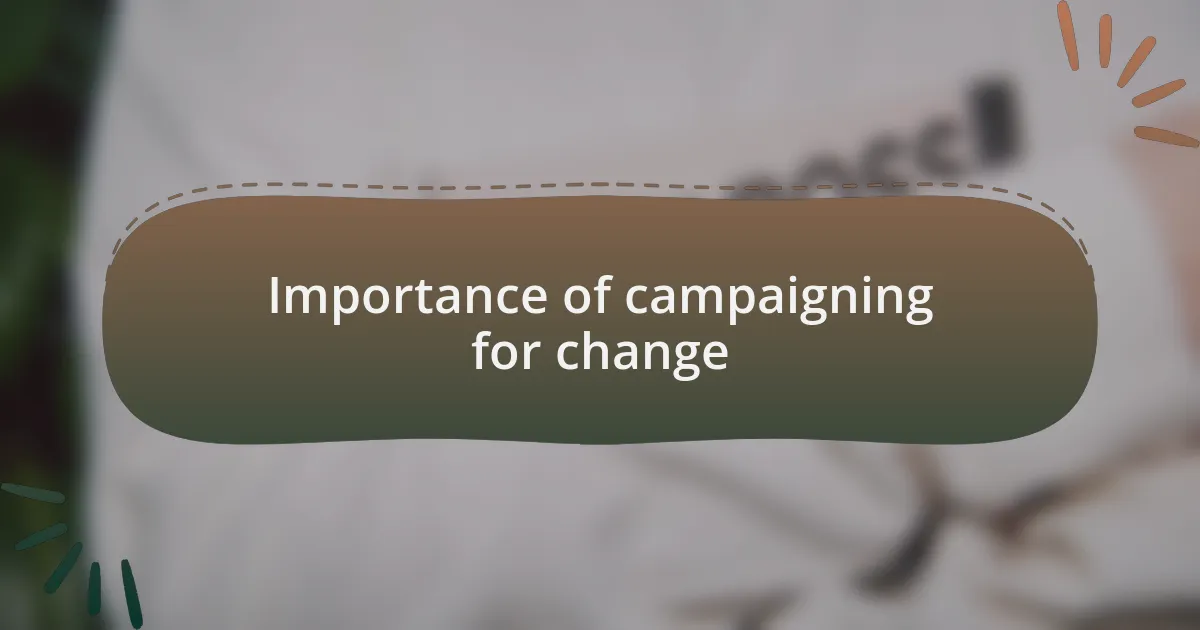
Importance of campaigning for change
Campaigning for change plays a crucial role in shaping societal attitudes and policies. I recall a particular rally where we gathered to protest unequal pay, chanting uplifting slogans. The energy was contagious, and I realized that a unified voice can challenge deep-rooted injustices. Isn’t it fascinating how collective action can push for tangible results?
Moreover, effective campaigning creates a platform for marginalized voices, often highlighting issues that mainstream discussions overlook. During one campaign, I collaborated with local leaders and learned firsthand how powerful visibility can be. It’s incredible what happens when people see themselves represented; it ignites a sense of belonging and inspires further advocacy. How can we expect change if we don’t spotlight those most affected?
Additionally, advocacy campaigns foster solidarity among diverse groups, helping to build a more inclusive movement. I remember a workshop where individuals from various backgrounds shared their experiences related to gender discrimination. The vulnerability and empathy displayed enriched our understanding of each other’s struggles. Doesn’t this shared experience create a stronger foundation for collective action? It underscores the idea that to achieve meaningful progress, we must unite in our efforts and support one another.
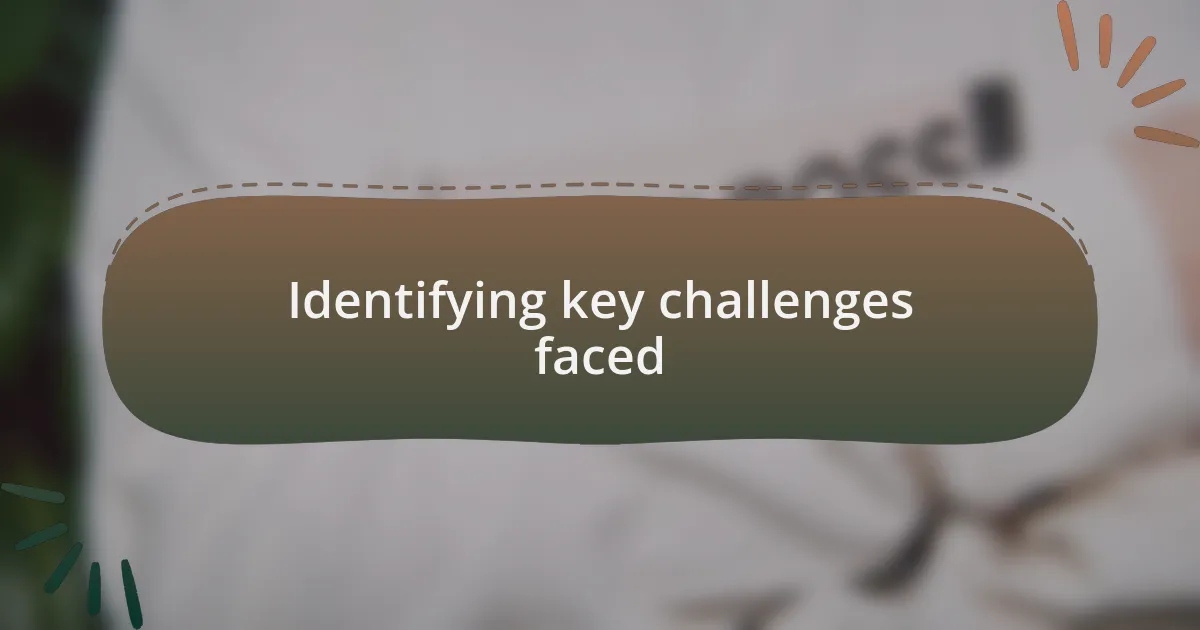
Identifying key challenges faced
Navigating the landscape of gender equality advocacy reveals several key challenges that demand our attention. One significant hurdle I’ve encountered is the resistance from established institutions resistant to change. I remember a particularly frustrating meeting where I presented data on gender disparities in leadership roles, only to be met with indifference. It’s disheartening when you realize that even well-documented issues can fall on deaf ears. What drives this apathy in decision-makers?
Another challenge lies in mobilizing consistent support within our communities. During my efforts to rally individuals for a campaign, I was surprised by how many people were unaware of the gender issues right in their backyard. I often found myself grappling with the question: How can I inspire action when many don’t even recognize the problem? This disconnect can be discouraging, but it also highlights the urgent need for education and awareness-raising initiatives.
Lastly, there’s often a lack of funding for grassroots movements, which can stifle progress. I vividly recall organizing a workshop that was intended to empower young women, but we had to cut down on some activities due to budget constraints. It made me question: Why do financial resources favor larger organizations over local advocates striving for change? This reality urges me to seek innovative solutions, proving that while challenges abound, they can motivate us to think creatively about overcoming them.
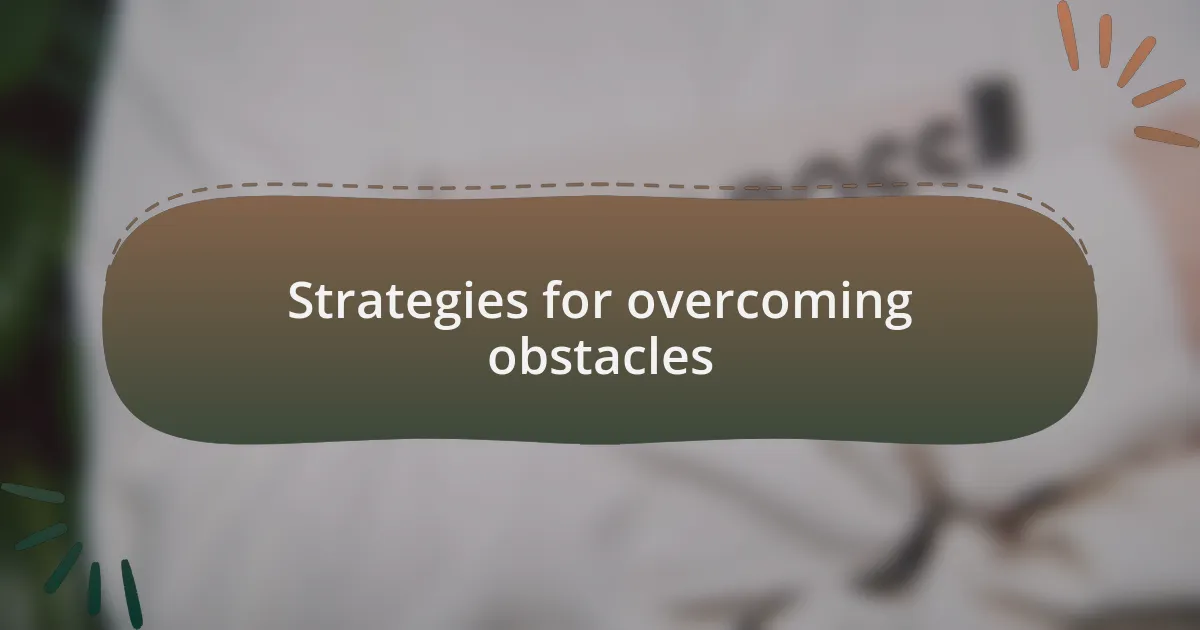
Strategies for overcoming obstacles
One effective strategy I found was to build alliances with local leaders who share similar visions. I remember approaching a community elder who had influence and respect; when he agreed to support our campaign, it shifted the perception of our cause. How often do we overlook the power of partnership? Engaging with those already trusted in the community helped bridge the gap between skepticism and support.
Another approach was to leverage storytelling. I often shared personal experiences that illustrated the impact of gender inequality. There was one instance where I recounted a friend’s struggle with workplace discrimination, and the room fell silent. It struck me that narratives have the ability to resonate deeply, making abstract concepts tangible. Have you ever considered how your own stories might inspire others?
Lastly, persistence became my greatest tool in seeking funding. I started learning how to write compelling grant proposals and adjusted my pitches based on feedback. With every rejection, I refined my approach and cultivated resilience. It’s a challenging journey, but overcoming those funding obstacles has made me appreciate the value of every small win. What if each setback is just a setup for a greater opportunity?
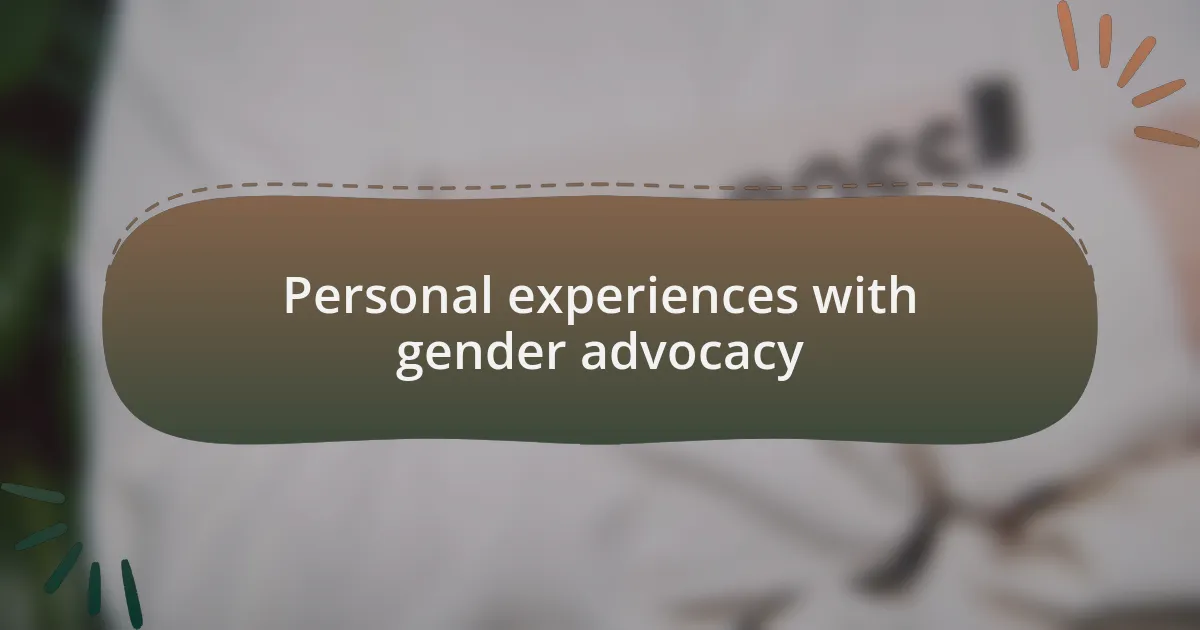
Personal experiences with gender advocacy
Engaging in gender advocacy often felt like navigating a maze, especially when faced with widespread misconceptions. I vividly remember attending a community event where I was met with skepticism from attendees who questioned the necessity of gender equality initiatives. Instead of being deterred, I chose to engage in thoughtful dialogue, helping me realize that empathy and education could dismantle preconceived notions. Isn’t it fascinating how open conversations can turn skepticism into support?
There was a moment I’ll never forget: I organized a workshop aimed at empowering young women in my community. A participant shared her experience of being sidelined at work simply because of her gender. Her raw emotion resonated with everyone in the room, including me. In that instant, I understood the power of shared experiences. Have you ever witnessed firsthand how vulnerability can spark transformation? It reaffirmed my belief in the importance of creating safe spaces for dialogue.
Reflecting on my journey, I can say that self-doubt was often my worst enemy. The first time I stood before a group to speak about gender equality, my hands trembled with nervousness. I questioned my credibility, wondering if my voice truly mattered. Over time, I learned to embrace those moments of uncertainty and turned them into fuel for my advocacy. What if we considered our self-doubt not as an obstacle but as a stepping stone toward authenticity?
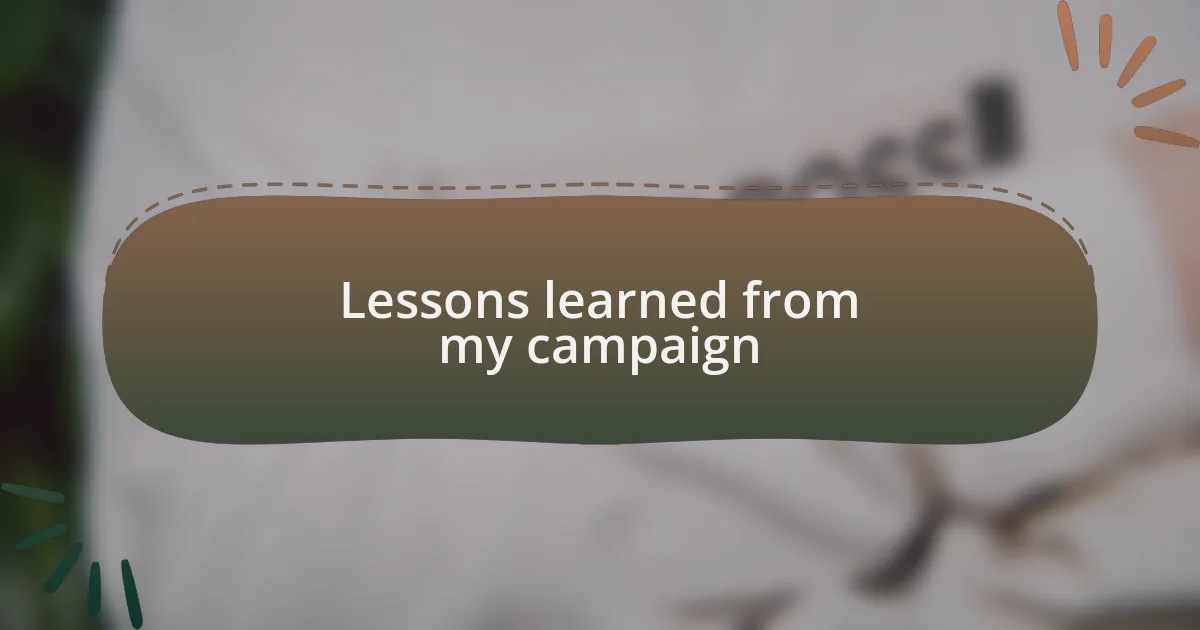
Lessons learned from my campaign
There were countless times during my campaign when I faced unexpected setbacks. One particular instance stood out: I had planned a large rally to promote gender equality, but a sudden storm forced us to cancel. It was disheartening, but that experience taught me the importance of adaptability. I learned to pivot my approach, shifting to virtual events, which ultimately widened our reach. Have you ever turned a seemingly negative situation into an opportunity?
Collaboration with other advocates was another lesson I cherished. Early on, I thought I could tackle every challenge alone, but I quickly found that teamwork significantly amplified our impact. Partnering with local organizations brought diverse perspectives that enriched our message. It’s reminded me that there is strength in unity, a realization I haven’t taken lightly since. How can we ever think we can achieve something monumental on our own?
Lastly, I came to appreciate the profound importance of listening. In one meeting, I was so eager to share my ideas that I neglected to hear the concerns voiced by community members. That oversight led to a disconnect in our messaging. After that, I made it a priority to actively listen before responding, fostering a culture of inclusion. Isn’t it interesting how much can change when we prioritize understanding over speaking?